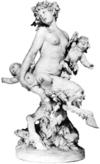- Clodion
-
orig. Claude Michelborn Dec. 20, 1738, Nancy, Fr.died March 29, 1814, ParisFrench sculptor.In 1755 he entered his uncle's workshop in Paris, and later he became a student of Jean-Baptiste Pigalle. In 1759 he won the grand prize at the Royal Academy and embarked on a successful career, first in Rome and then in Paris, where he exhibited regularly at the Salon. He excelled at small statuettes and terra-cotta figures of nymphs, satyrs, and groups. After the French Revolution he changed his style to suit the Neoclassical taste for monumentality; he worked on the Arc de Triomphe du Carrousel (1805–06) and the Vendôme Column (1806–09).
 "Female Satyr Carrying Two Putti," terra-cotta statuette by Clodion; in the Walters Art ...By courtesy of the Walters Art Gallery, Baltimore
"Female Satyr Carrying Two Putti," terra-cotta statuette by Clodion; in the Walters Art ...By courtesy of the Walters Art Gallery, Baltimore* * *
▪ French sculptororiginal name Claude Michelborn Dec. 20, 1738, Nancy, Fr.died March 29, 1814, ParisFrench sculptor whose works represent the quintessence of the Rococo style.In 1755 Clodion went to Paris and entered the workshop of Lambert-Sigisbert Adam, his uncle. On his uncle's death, he became a pupil of J.B. Pigalle. In 1759 he won the grand prize for sculpture at the Académie Royale de Peinture et de Sculpture, and in 1762 he went to Rome. Catherine II was eager for him to come to St. Petersburg, but he returned to Paris in 1771. There he was successful and frequently exhibited at the Salon.Clodion worked mostly in terra-cotta, his preferred subject matter being nymphs, satyrs, bacchantes, and other classical figures sensually portrayed. He was also, with his brothers, a decorator of such objects as candelabra, clocks, and vases. Perhaps because of his apparent unwillingness to be seriously monumental, he was never admitted to the Royal Academy. Nevertheless, after the Revolution had driven him in 1792 to Nancy, where he lived until 1798, he was flexible enough to adapt himself to Neoclassical monumentality—the relief on the Arc de Triomphe du Carrousel, representing the entry of the French into Munich, is an example.* * *
Universalium. 2010.
